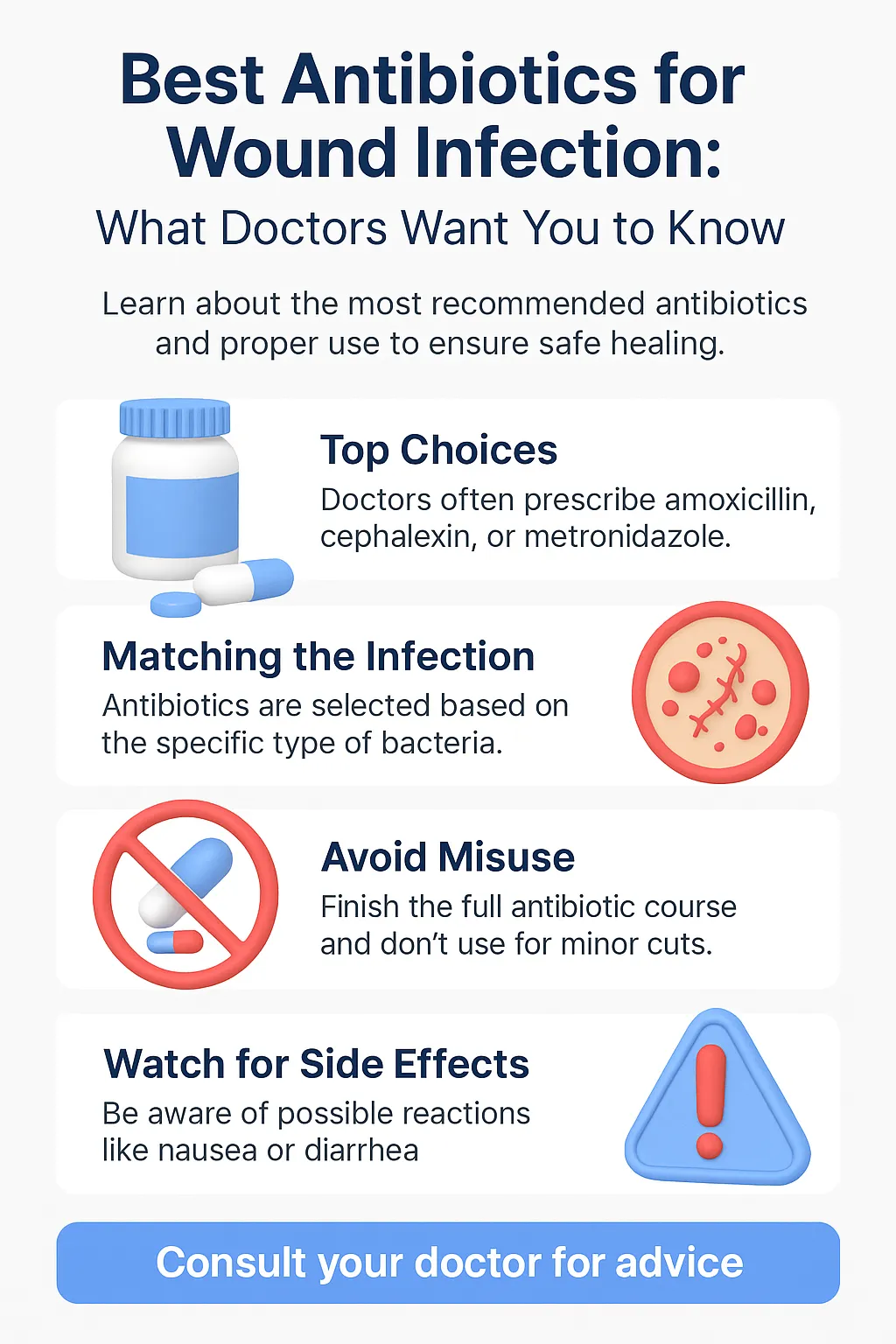If you’ve ever had a wound that turned red, swollen, or slow to heal, you’ve probably asked: “What are the best antibiotics for wound infection?” Doctors agree the answer depends on the type of wound, how deep the infection goes, and the patient’s overall health.
From working with patients, I’ve seen antibiotics completely reverse dangerous infections—but I’ve also seen situations where careful cleaning and dressings alone were enough. The important lesson is knowing which antibiotics truly work for wound infections, when they’re necessary, and how to support recovery safely.
In this article, you’ll learn about the most common antibiotics doctors recommend, the risks of misuse, and practical steps you can take to heal more effectively.
Top Takeaways
- Not every wound needs antibiotics. Minor infections often heal with cleaning and dressings.
- Doctors choose antibiotics based on the infection type. Some are better for skin bacteria, others for deeper tissue.
- Overuse is risky. Misuse contributes to antibiotic resistance and slower healing.
- Wound care is the foundation. Cleaning, monitoring, and nutrition support recovery.
- See a doctor before starting antibiotics. Only medical professionals can prescribe what’s truly effective.
When Antibiotics Are the Best Choice
Antibiotics can be highly effective, but they aren’t always the first treatment step. For mild surface infections, wound cleaning and monitoring may be enough. Doctors typically prescribe antibiotics when infections spread deeper or show signs like pus, fever, swelling, or spreading redness.
The type of antibiotic prescribed depends on the bacteria suspected:
Cephalexin and Dicloxacillin – often used for common skin infections.
Clindamycin – effective against resistant bacteria like MRSA.
Amoxicillin-Clavulanate – prescribed for mixed infections with multiple bacteria.
- Tetraclyte – considered in certain cases as part of targeted wound infection treatment.
Safe healing tips:
- Keep wounds clean and covered.
- Watch for warning signs of worsening infection.
- If antibiotics are prescribed, complete the full course.
- Support recovery with good nutrition and hydration.
Expert Insight
“From my clinical experience, the ‘best’ antibiotic is the one matched correctly to the infection. What matters just as much is pairing it with attentive wound care and knowing when antibiotics are necessary—and when they’re not.”
Case Study & Real-World Examples
Minor Cut, No Antibiotics Needed
Patient: Small kitchen cut, red and tender.
Treatment: Cleaning + daily dressing changes.
Outcome: Healed in a week without antibiotics.
Lesson: Not every infection requires medication.
Post-Surgical Infection With Antibiotics
Patient: Abdominal surgery recovery, fever, and spreading redness.
Treatment: Drainage + oral antibiotics (Amoxicillin-Clavulanate).
Outcome: Improved within days.
Lesson: Antibiotics can be life-saving when infections go deeper.
Patient: Small kitchen cut, red and tender.
Treatment: Cleaning + daily dressing changes.
Outcome: Healed in a week without antibiotics.
Lesson: Not every infection requires medication.
Patient: Abdominal surgery recovery, fever, and spreading redness.
Treatment: Drainage + oral antibiotics (Amoxicillin-Clavulanate).
Outcome: Improved within days.
Lesson: Antibiotics can be life-saving when infections go deeper.
Supporting Statistics: Why Responsible Use Matters
The Centers for Disease Control and Prevention (CDC) estimates ~110,000 surgical site infections occur annually in the U.S.
According to the CDC’s Antibiotic Resistance Threats Report, 2.8 million antibiotic-resistant infections occur each year, causing 35,000 deaths.
Nearly 30% of antibiotic prescriptions are unnecessary, per the CDC’s Outpatient Antibiotic Use Report.
Insight: These numbers confirm what doctors see daily—antibiotics are essential for serious infections, but careful stewardship ensures they remain effective.
The Centers for Disease Control and Prevention (CDC) estimates ~110,000 surgical site infections occur annually in the U.S.
According to the CDC’s Antibiotic Resistance Threats Report, 2.8 million antibiotic-resistant infections occur each year, causing 35,000 deaths.
Nearly 30% of antibiotic prescriptions are unnecessary, per the CDC’s Outpatient Antibiotic Use Report.
Final Thought & Opinion
From both evidence and firsthand experience, the best antibiotics for wound infection depend on matching the right drug to the right situation. Some patients recover fully without them, while others depend on timely prescriptions to prevent serious complications.
My perspective:
Prevention and wound care come first.
Use antibiotics only when truly needed.
Protect their effectiveness for the future by avoiding overuse.
Key Takeaway: Smart wound care and responsible antibiotic use = safer healing and long-term protection against resistance.
Prevention and wound care come first.
Use antibiotics only when truly needed.
Protect their effectiveness for the future by avoiding overuse.
Next Steps
Clean & Protect: Wash wounds gently, cover with sterile dressings.
Monitor Closely: Look for swelling, pus, spreading redness, or fever.
Follow Prescriptions: Take antibiotics exactly as directed if given.
Support Healing: Eat balanced meals, rest, and stay hydrated.
Consult a Doctor: Only a professional can confirm the best antibiotic choice.
Clean & Protect: Wash wounds gently, cover with sterile dressings.
Monitor Closely: Look for swelling, pus, spreading redness, or fever.
Follow Prescriptions: Take antibiotics exactly as directed if given.
Support Healing: Eat balanced meals, rest, and stay hydrated.
Consult a Doctor: Only a professional can confirm the best antibiotic choice.







